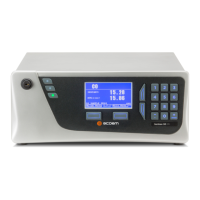TÜV Rheinland Energie und Umwelt GmbH
Luftreinhaltung
Seite 18 von 253
Report on the performance testing of the Serinus 30 ambient air quality
monitoring system manufactured by Ecotech Pty Ltd measuring CO, Report
EP_Ecotech_Serinus30_en.docx
Performance criterion Minimum requirement Test result Com-
pliance
Page
5.3.15 Difference between
sample and calibra-
tion port
The difference between the
measured values obtained by
feeding gas at the sample and
calibration port shall not ex-
ceed the requirements listed in
Table 2 of VDI Guideline 4202
Sheet 1 (September 2010).
Please refer to section 7.1
8.4.13 Difference sam-
ple/calibration port.
yes 67
5.3.16 Converter efficiency
In case of measuring systems
with a converter, the converter
efficiency shall be at least
98 %.
This test item does not apply as the
measuring system does not use a
converter.
Not
appli-
cable
68
5.3.17 Increase of NO2 con-
centrations due to
residence in the
measuring system
In case of NO
X
measuring sys-
tems the increase of NO
2
con-
centration due to residence in
the measuring system shall not
exceed the requirements listed
in Table 2 of VDI Guideline
4202 Sheet 1 (September
2010).
Not applicable as the measuring sys-
tem does not measure NOX.
Not
appli-
cable
69
5.3.18 Overall uncertainty
The expanded uncertainty of
the measuring system shall be
determined. The value deter-
mined shall not exceed the cor-
responding data quality objec-
tives specified in the applicable
EU
Directives on air quality as
listed in Annex A, Table A
1 of
VDI Guideline 4202 Sheet 1
(September 2010).
The determination of uncertainty was
performed in accordance with DIN EN
14626 (2012) and is detailed in sec-
tion 7.1 8.6
Total uncertainty
in accordance with Annex E of DIN
EN 14626 (2012).
yes 70
8.4 Requirements of Standard DIN EN 14626
8.4.3 Response time
Neither the response time
(rise) nor the response time
(fall) shall exceed 180 s.
The
difference between rise and fall
response time shall not exceed
10
10 s, depending on which val-
ue is larger.
The maximum permissible response
time of 180
s is exceeded at no time.
The maximum response time deter-
mined is 52 s for system 1 and 56 s
for system 2.
yes 71

